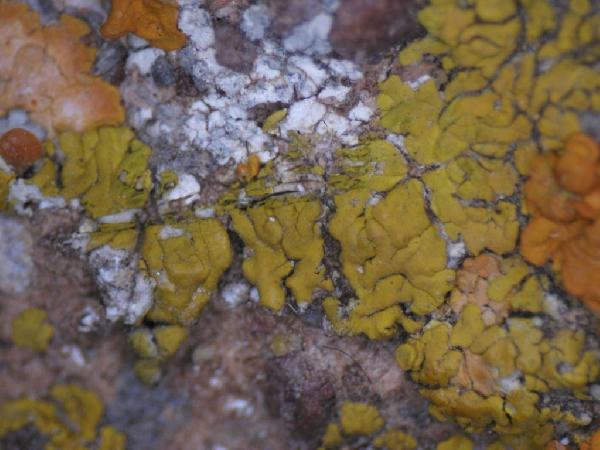Candelariella senior Poelt
Mitt. bot. Staatsamml. München 19-20: 440, 1958.
Synonyms:
Distribution:
Description: Thallus crustose-placodioid, episubstratic, pale yellow to yellow-orange, forming up to 8(-10) mm wide, often confluent rosettes, the central part areolate, often paler, the marginal lobes up to 3 mm long, weakly convex, apically often slightly broader, smooth to finely granulose (especially at tips). Cortex 10-30 µm thick, of isodiametric, 2-4 wide cells; algal layer usually interrupted. Apothecia abundant in central parts of thallus, lecanorine, c. 0.8 mm across, round, constricted at base, concolorous with thallus, with an evident, yellow-orange margin. Epithecium orange; hymenium colourless, 60-80 µm high; paraphyses coherent, the apical cells slightly swollen; hypothecium colourless. Asci 8-spored, clavate, with an apical dome which is I+ blue only in the internal, lower part, interrupted in the centre by an I+ paler blue strip, Candelaria-type. Ascospores 1-celled to rarely 1-septate, hyaline, oblong to narrowly ellipsoid, 10-14(-16) x (3-)4-5(-6) µm. Photobiont chlorococcoid. Spot tests: thallus K- or K+ faintly orange, C-, KC-, P-. Chemistry: thallus and apothecia with pulvinic acid derivatives. Note: a calcicolous and nitrophilous species described from SE Spain, and also known from North Africa (Algeria, Libya, Tunisia); it is closely related to C. medians but lacks any vegetative diaspores and is always abundantly fertile. To be looked for in the driest parts of Southern Italy, especially in Sicily.
Growth form: Crustose placodiomorph
Substrata: rocks
Photobiont: green algae other than Trentepohlia
Reproductive strategy: mainly sexual

Predictive model
Growth form: Crustose placodiomorph
Substrata: rocks
Photobiont: green algae other than Trentepohlia
Reproductive strategy: mainly sexual

Predictive model


